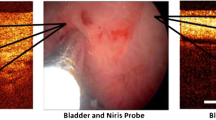Abstract
Intraluminal optical coherence tomography (OCT) applies coherent light to provide cross-sectional images with a spatial resolution of 10–25 μm. We compared OCT and matching whole-mount histology microscopy sections of porcine upper ureters ex vivo for visualization and delineation of different tissue layers of the ureteral wall. Porcine ureters (six specimens, 24 quadrants) were flushed with normal saline solution prior to insertion of the OCT catheter (diameter, 0.014 inch, OCT wavelength, 1,300±20 nm). Cross-sectional OCT images were obtained in marked locations before specimens were fixed in 4% formalin, cut at marked locations, whole-mounted, and stained with hematoxilin and eosin. Visualization and delineation of different tissue layers of the ureteral wall by OCT was compared with matching histology by two independent observers (O1,O2). OCT distinguished tissue layers of the ureteral wall in all quadrants. In OCT images, O1/O2 delineated urothelium and lamina propria in 23/24 quadrants, lamina propria and muscle layer in 19/16 quadrants, inner and outer muscle layer in 13/0 quadrants, and urothelial cell layers in 13/2 quadrants, respectively. Intraluminal OCT provides histology-like images of the ureter in porcine specimens ex vivo and reliably distinguishes between urothelium and deeper tissue layers of the ureteral wall.



Similar content being viewed by others
References
Tearney GJ, Brezinski ME, Southern JF, Bouma BE, Boppart SA, Fujimoto JG (1997) Optical biopsy in human urologic tissue using optical coherence tomography. J Urol 157:1915–1919
Brezinski ME, Tearney GJ, Weissman NJ, Boppart SA, Bouma BE, Hee MR, Weyman AE, Swanson EA, Southern JF, Fujimoto JG (1997) Assessing atherosclerotic plaque morphology: comparison of optical coherence tomography and high frequency intravascular ultrasound. Heart 77:397–403
Fujimoto JG, Boppart SA, Tearney GJ, Bouma BE, Pitris C, Brezinski ME (1999) High resolution in vivo intra-arterial imaging with optical coherence tomography. Heart 82:128–133
Tearney GJ, Brezinski ME, Southern JF, Bouma BE, Boppart SA, Fujimoto JG (1997) Optical biopsy in human gastrointestinal tissue using optical coherence tomography. Am J Gastroenterol 92:1777–1779
Boppart SA, Bouma BE, Pitris C, Tearney GJ, Southern JF, Brezinski ME, Fujimoto JG (1998) Intraoperative assessment of microsurgery with three-dimensional optical coherence tomography. Radiology 208:81–86
Jesser CA, Boppart SA, Pitris C, Stamper DL, Nielsen GP, Brezinski ME, Fujimoto JG (1999) High resolution imaging of transitional cell carcinoma with optical coherence tomography: feasibility for the evaluation of bladder pathology. Br J Radiol 72:1170–1176
Zagaynova EV, Streltsova OS, Gladkova ND, Snopova LB, Gelinkova, Feldchtein FI, Morozov AN (2002) In vivo optical coherence tomography: feasibility for bladder disease. J Urol 167:1492–1496
Pan YT, Xie TQ, Du CW, Bastacky S, Meyer S, Zeidel ML (2003) Enhancing early bladder cancer detection with fluorescence-guided endoscopic optical coherence tomography. Opt Lett 28:2485–2487
Acknowledgements
Parts of the work presented herein are based on results of doctoral thesis work in preparation by Margit Bauer at the Medical Faculty, University of Munich, Germany. We gratefully acknowledge the technical assistance provided by staff members from LightLab Imaging, Westford, Mass., USA. Catheter-based intraluminal optical coherence tomography (OCT) of the ureter: ex-vivo correlation with histology in porcine specimens.
Author information
Authors and Affiliations
Corresponding author
Rights and permissions
About this article
Cite this article
Mueller-Lisse, U.L., Meissner, O.A., Babaryka, G. et al. Catheter-based intraluminal optical coherence tomography (OCT) of the ureter: ex-vivo correlation with histology in porcine specimens. Eur Radiol 16, 2259–2264 (2006). https://doi.org/10.1007/s00330-006-0191-8
Received:
Revised:
Accepted:
Published:
Issue Date:
DOI: https://doi.org/10.1007/s00330-006-0191-8




